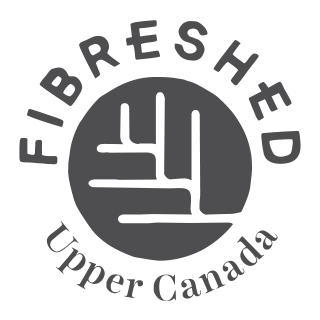Opportunities to find Fibreshed products that support Ontario farm and textile communities while nourishing our land, are getting more abundant as our organization grows. We have been working to find new venues and ways to showcase the best of what our bioregion has to offer in a way that is celebratory and builds community. Black Sheep was one such event. If you are not familiar with the Elora Centre for the Arts, the home of the Black Sheep Festival of Contemporary Textile Art, it’s ok, we were new to them also – but bookmark their website, do check out some of their on-going workshops and programming, and absolutely make sure you attend Black Sheep next summer. You won’t want to miss it.

As the special guests of the festival, it was really lovely to see so many of our members all in one place, showing off their talents and skills. A special thank you to Sarah Craig and Bonnie from the Ontario Handweavers and Spinners who brought a loom and spinning wheel to our (bio)regional demonstration tent. Christopher Walker, of Cabin Boy Knits and his partner Jamie (not pictured) attracted interest in their natural dye pots: marigold, lilac leaves and rhubarb leaves stole the show with buttery shades of yellow, and rusty orange, not to mention the infamous dye rack of (naked) instagram-post fame. Curious onlookers had many a good question – and experienced dyers had loads of ideas to share.

Ruth Thoem had some lovely handwoven tea towels and local wool throws, while Melanie spun yarn. Romy Shill of Circle R Livestock and her mom had all kinds of products from her farm: yarns, sheep skins, hand-knit hats and wool-stuffed pillows. Linc Farm’s Juliet brought a suitcase of all-natural, undyed locally-spun yarns in the deepest shades of brown, with cream and white hand-spun yarns and roving for all your dreamy, summer fibre projects along with felted dryer balls, of which she has a surprising way of making them. Laundry has never been so interesting! Christine Donovan’s hand needle-felted chickadees and other birds stole the heart of more than one of my family members, and many other festival attendees.

Gail Franklin-Hawes of G N R Alpaca was busy all morning, sending off soft, luxurious alpaca roving, yarns, handwoven blankets, and carded fibre to new homes, while Laura and Bree knit with local yarns in our information booth. Erin introduced a number of people to the drop spindle, I’m sure they are now life-long fibre enthusiasts (not pictured). A very big thank you to Peggy Sue Collection, for lending us three, handwoven, knit and felted, wool-alpaca jackets and a dress made in Toronto, to demonstrate the potential of the bioregion to produce world-class apparel. Peggy Sue, you continue to inspire us all, give us hope and encourage the much needed behind-the-scenes capacity-building needed to make your creations the normal and not the goal post.

Dianne Kennedy-Cruttenden wove two special shawls to compliment her collection. In her own words, “This is my expression of the Ontario ‘Upper Canada’ Fibreshed. Hand woven with exceptionally soft yarn from sheep, mohair goats and alpaca all within Wellington County, woven on my Canadian made loom in Fergus, Ontario. The shawl pin is made of Ontario copper and hand-forged by my talented husband.” A beautiful example of the regional supply chain. Nicole Varney, Spontaneous Atelier, had a display of naturally dyed jackets and shirts plus this incredible dye wheel of botanical colours from Ontario.

Our members were using the producer tags to identify the items that embody the Fibreshed ethos of local dyes, local fibre and local labour. These examples demonstrate the potential of our community to support bioregional approaches to clothing and textile production. It’s a small, worthy step towards honouring and in turn nurturing the life-giving properties of our (bio)regions.

